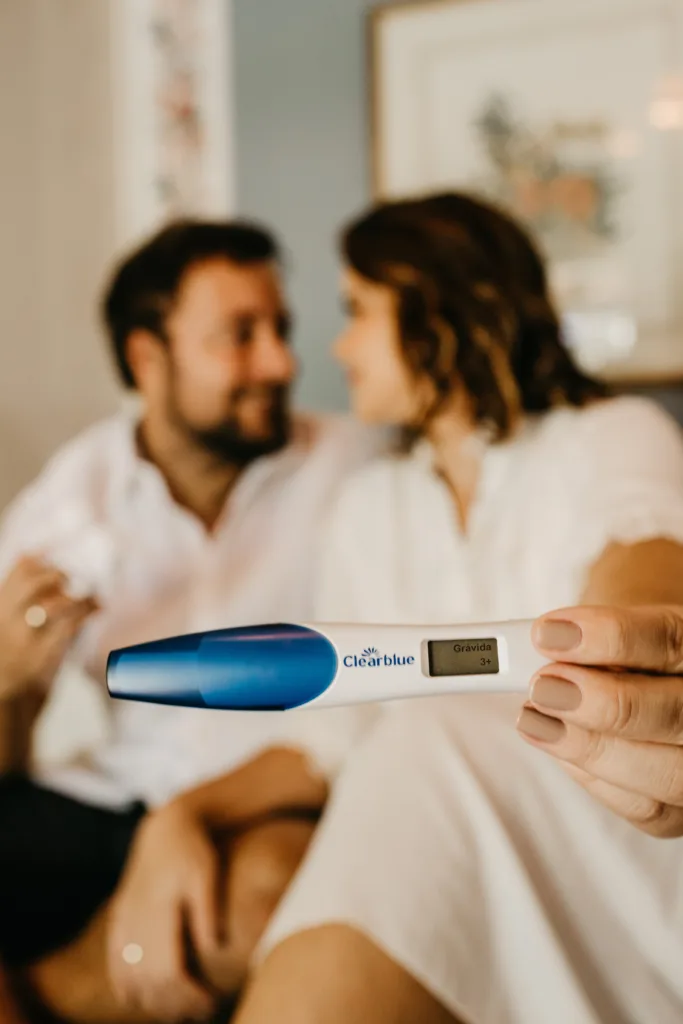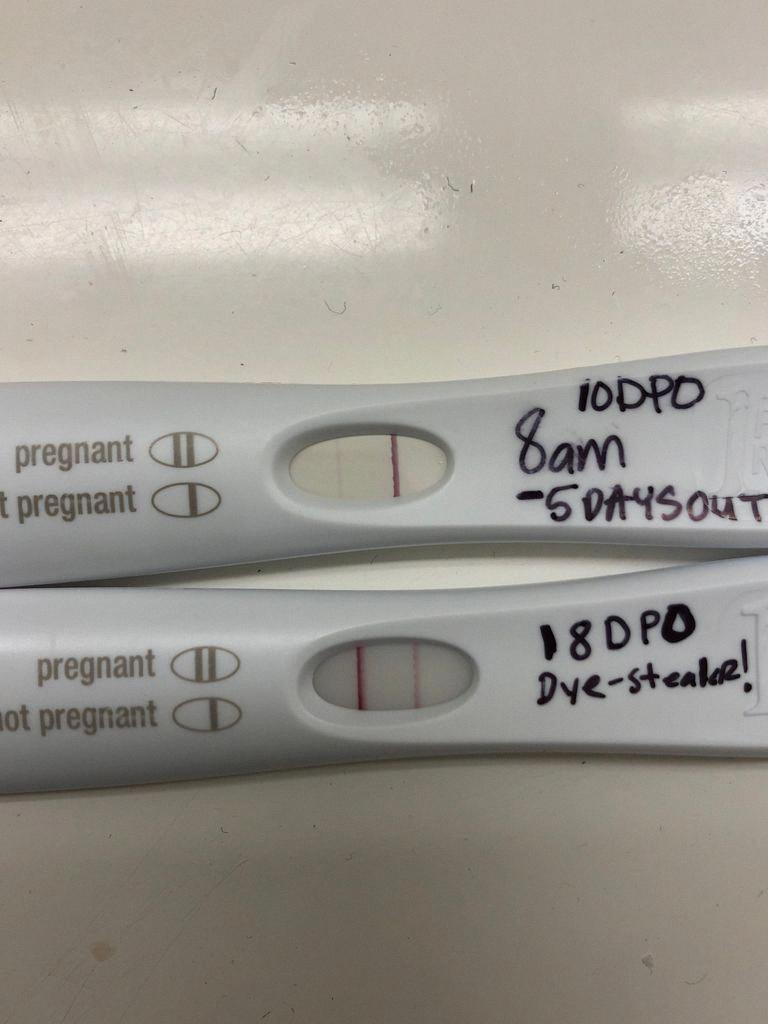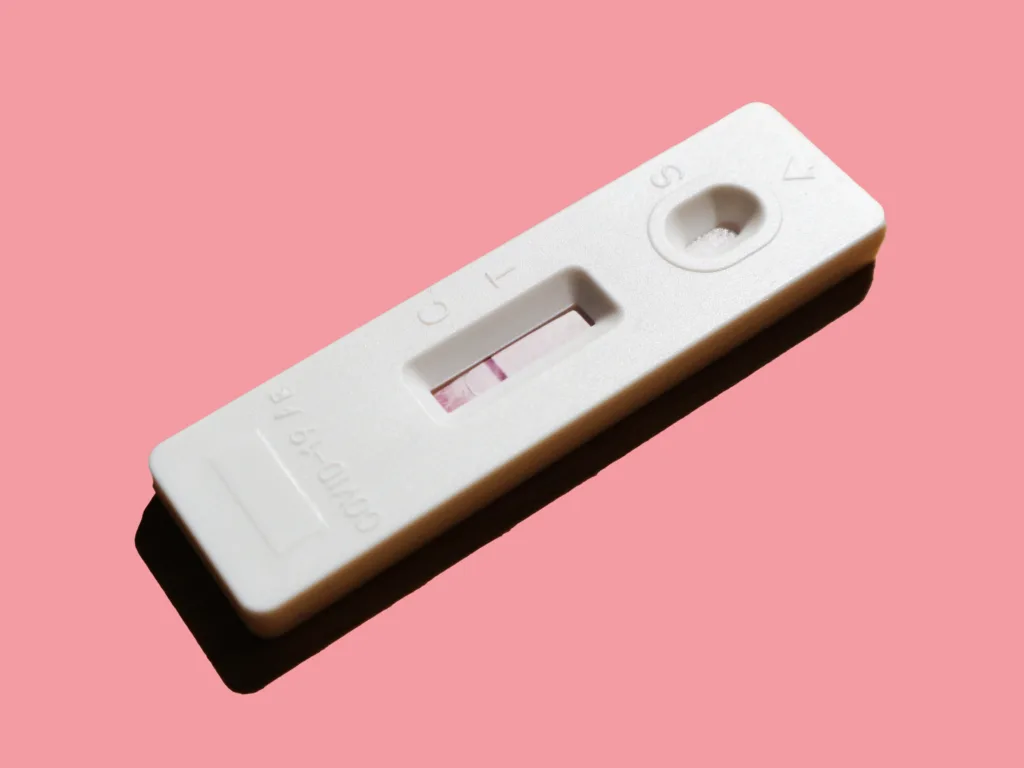If you’re trying to conceive and have been using pregnancy tests to track your progress, you may have heard of the term “dye stealer.” This term refers to a situation were the positive test line on a pregnancy test is stronger than the control line, indicating a high level of hCG in the urine. In this blog post, we’ll explore what a dye stealer test means, how it relates to twin pregnancies, and what you should do if you get a dye stealer result.
First off, let’s talk about what hCG is and why it matters for pregnancy tests. hCG, or human chorionic gonadotropin, is a hormone that is produced by the placenta after a fertilized egg implants in the uterus. It is the hormone that most pregnancy tests detect in order to determine if a woman is pregnant. hCG levels increase rapidly in the first few weeks of pregnancy, which is why early pregnancy tests are often able to detect pregnancy before a missed period.
Now, let’s talk about dye stealer tests. As we mentioned earlier, a dye stealer test occurs when the positive test line on a pregnancy test is stronger than the control line. This happens when there is a high level of hCG in the urine, which can be an indication of a twin pregnancy or a pregnancy that is further along than expected. In some cases, a dye stealer test can also be a sign of a molar pregnancy, which is a rare type of pregnancy in which abnormal cells grow instead of a fetus.
So what should you do if you get a dye stealer result? First off, congratulations! A dye stealer test is a strong indication that you are indeed pregnant. However, it’s important to confirm your results with a healthcare provider. They can perform a blood test to measure your hCG levels and determine if you are carrying twins or if there is another reason for the high level of hCG in your urine.
A dye stealer test can be an exciting and surprising result for those trying to conceive. It’s important to confirm your results with a healthcare provider and to keep in mind that a dye stealer result doesn’t necessarily mean you are carrying twins. Regardless, a strong positive test result is a great reason to celebrate and start planning for your new addition to the family.
What Is a Dye Stealer?
A dye stealer on a pregnancy test occurs when the positive test line is stronger than the control line, resulting in the control line appearing faint. This phenomenon happens when the levels of the hormone hCG, which the pregnancy test is detecting, are very high. The positive test line becomes so strong that it “steals” the dye meant for the control line, causing it to appear faint or almost invisible. Essentially, a dye stealer test is a very positive result, indicating that the individual taking the test is likely to be well into their pregnancy.

Do Twins Have a Dye Stealer?
A dye stealer pregnancy test occurs when the line on a pregnancy test becomes so dark that it steals dye from the control line. This hapens when there is an abundance of human chorionic gonadotropin (HCG) in the body, which is the hormone produced during pregnancy. While a dye stealer pregnancy test could be an indication of a twin pregnancy, it is not a definitive sign. There are many factors that can influence HCG levels, and a high level of HCG does not necessarily mean there are two embryos. Other factors that could lead to a dye stealer pregnancy test include miscalculating the due date, a molar pregnancy, or a blighted ovum. Therefore, the only way to confirm a twin pregnancy is through an ultrasound scan.
What Does a Positive Result Mean if the Dye Runs on a Pregnancy Test?
If the dye runs on a pregnancy test, it means that the test is invalid and cannot be interpreted as a positive or negative result. The dye running can occur if the test is left sitting for too long, if it is not used properly, or if there is a defect with the test itself. It is important to follow the instructions carefully and read the results within the specified time frame to ensure accurate results. If the test is invalid due to dye running, it is recommended to take another test to confirm the results.
Interpreting the Meaning of a Dark Red Line on a Pregnancy Test
A dark red line on a pregnancy test typically means that you are pregnant. The line appears when the test detects the presence of the hormone human chorionic gonadotropin (hCG), which is produced by the placenta after a fertilized egg implants in the uterus. A dark red line typically indicates a higher concentration of hCG in your urine, which is a sign that your pregnancy is progressing. It is important to follow up with your healthcare provider to confirm your pregnancy and begin prenatal care.
The Significance of a Darkening Pregnancy Test Line
It is a positive sign if the pregnancy test line gets darker over time. This is because a darker line indicates a higher concentration of the hormone human chorionic gonadotropin (hCG), which is produced by the developing placenta after a fertilized egg implants in the uterus. In a healthy pregnancy, hCG levels should double every 2 to 3 days, so a darker line on a pregnancy test indicates that these levels are increasing as expected. However, it is important to note that a faint line on a pregnancy test can still indicate a viable pregnancy, especialy if it is taken early on in the pregnancy. It is always recommended to confirm a positive pregnancy test result with a healthcare provider.

Source: community.whattoexpect.com
Does a Darker Pregnancy Test Result Indicate Higher Levels of HCG?
A darker pregnancy test typically indicates a higher concentration of hCG (human chorionic gonadotropin) in the body. Home pregnancy tests work by detecting hCG in urine, which is produced by the placenta after a fertilized egg implants in the uterus. The concentration of hCG in the body increases rapidly in the first few weeks of pregnancy, doubling approximately every 48 to 72 hours. As a result, if you take a pregnancy test every few days during early pregnancy, the line on the test should get progressively darker as hCG levels increase. However, it is important to note that the darkness of the line on a pregnancy test is not a precise measurement of hCG levels, and other factors such as the sensitivity of the test and the amount of urine used can also affect the result. If you have any concerns or questions about your pregnancy test results, it is aways best to consult with a healthcare provider.
Signs of Twins Implantation
Implantation is the process in which the fertilized egg attaches iself to the uterine wall. While there are no specific signs of twins implantation, some women may experience certain symptoms that could indicate a twin pregnancy. These signs may include more intense morning sickness, tummy troubles such as bloating and constipation, extreme fatigue, and more weight gain earlier in the pregnancy. Additionally, some women may experience an increased appetite, and they may feel more fetal movement than they normally would during a single pregnancy. It’s important to note that while these signs could potentially indicate a twin pregnancy, the only way to confirm it is through an ultrasound.
Dark Pregnancy Test Results at 5 Weeks
Congratulations on your pregnancy! Pregnancy test results can vary in darkness depending on the level of the pregnancy hormone, human chorionic gonadotropin (hCG), in your urine. At 5 weeks of pregnancy, your hCG levels are likely to be high, which wold explain why your pregnancy test is showing a dark line. Additionally, hCG typically doubles every two to three days during the first few weeks of pregnancy, so your hCG levels could have increased significantly since your last test. This is a positive sign that your pregnancy is progressing well. However, it’s important to remember that pregnancy test results can vary depending on the brand of test, the time of day, and how much liquid you’ve consumed. If you have any concerns about your pregnancy, it’s always best to consult with your healthcare provider.
Can HCG Levels Distinguish Between Twins?
HCG, or Human Chorionic Gonadotropin, is a hormone that is produced by the placenta after a fertilized egg implants in the uterus. It is often used as an indicator of pregnancy, as hCG levels increase rapidly in the first few weeks of pregnancy. While it is true that elevated hCG levels can be a sign of a twin pregnancy, it is not a definitive indicator. There are several factors that can affect hCG levels, including the age of the mother, the gestational age of the pregnancy, and even the time of day when the test is taken. Therefore, it is important to note that the only way to confirm whether or not you are carrying twins is though an ultrasound performed by a trained medical professional.

The Variation of HCG Levels Throughout the Day
HCG levels are generally higher in the morning than at night. This is because hCG is produced by the placenta, which is most active during the night. Additionally, hCG levels can be affected by how much fluid you drink during the day. If you test in the afternoon or evening, your urine may be more diluted, which can make it harder to detect hCG. Therefore, if you want to get the most accurate results, it’s best to test your urine first thing in the morning before you have had anything to drink.
Are Blue Dye Tests More Sensitive Than Other Tests?
There is a common belief that blue dye tests are less sensitive than their pink dye counterparts. However, this is not necessarily true. Both blue and pink dye tests have a similar sensitivity in detecting human chorionic gonadotropin (hCG) in urine, which is the hormone produced during pregnancy. The sensitivity of both types of tests typically ranges from 25 to 50 mIU/mL, meaning they can detect hCG at very low levels in urine.
It is important to note that the accuracy of any pregnancy test depends on several factors, including the timing of the test, the quality of the test, and the individual’s unique physiology. Additionally, the interpretation of test results can be influenced by user error, such as reading the test after the recommended time frame or failing to follow the test instructions properly.
While blue dye tests may not be more sensitive than pink dye tests, they are still a reliable option for early detection of pregnancy. It is always recommended to follow the instructions carefully and consult with a healthcare professional if there is any uncertainty or concern aout the results.
Do All Blue Dye Tests Show an Evaporation Line?
Not all blue-dye pregnancy tests have evaporation lines, but they are notorious for producing false-positive results due to the formation of evaporation lines. Evaporation lines usually appear after the allotted testing time and can be mistaken for a positive test result. However, if the test is read within the recommended time frame and the result is negative, there should be no visible line at all – evaporation or otherwise. It is always important to follow the instructions carefully when taking a pregnancy test, regardless of the brand or type.
Darker Test Line than Control Line: Causes and Explanations
If your test line is darker than your control line on a pregnancy test, it is likely because your HCG level is higher than the minimum threshold detected by the test. HCG is a hormone that is produced by the placenta afer a fertilized egg implants in the uterus, and it is the hormone that most pregnancy tests are designed to detect. As your HCG level increases, the test line on the pregnancy test will become darker. This is because the antibodies on the test strip are binding to more HCG molecules in your urine, causing the test line to become more visible. So, if your test line is darker than your control line, it is a good indication that you are indeed pregnant and that your HCG levels are rising. However, it’s important to follow the instructions on the test carefully and interpret the results within the specified time frame to ensure accurate results.

Are Digital Pregnancy Tests More Accurate Than Traditional Tests?
Digital pregnancy tests are not necessarily more accurate than traditional analog tests. Both types of tests work in the same way, by detecting the presence of the hormone human chorionic gonadotropin (hCG) in urine. The difference betwen the two types of tests is the way they display the results. Analog tests show the result with lines or symbols, while digital tests display the result with words such as “pregnant” or “not pregnant.”
The accuracy of any pregnancy test depends on several factors, including when you take the test and how soon after conception you test. If you test too early, the levels of hCG in your urine may not be high enough to be detected by the test, which could result in a false negative.
In general, most digital pregnancy tests claim to be over 99% accurate when used on the day of your expected period. However, it’s important to note that the accuracy of any pregnancy test can be affected by factors such as medication or medical conditions that affect hCG levels.
While digital pregnancy tests may be more convenient for some women, they are not necessarily more accurate than traditional analog tests. It’s important to follow the instructions carefully and to test at the right time to ensure accurate results. If you have any concerns or questions about pregnancy testing, it’s always best to consult with a healthcare provider.
Darkness of the Control Line on a Pregnancy Test
The control line on a pregnancy test is usually darker than the test line because it serves as a reference point for the test results. The control line contains a fixed amount of dye that reacts with the antibodies in the test to show that the test is working correctly. The test line, on the oher hand, shows the result of the test, and its darkness depends on the level of the hormone hCG present in the urine sample. Therefore, the control line must always be darker than the test line to ensure that the test has been executed correctly and to prevent false negative results.
Conclusion
A dye stealer pregnancy test is a phenomenon where the positive test line on a pregnancy test is stronger than the control line, indicating high levels of hCG in the urine. This can happen in cases of twin pregnancies, where there is a higher level of hCG present. A very faint line on a pregnancy test can also indicate the early stages of pregnancy, but it is important to confirm the result by testing again a few days or weeks later. understanding the concept of a dye stealer can provie valuable information for those trying to conceive or monitor the progression of their pregnancy.
